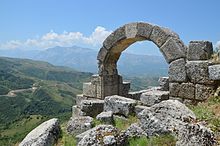Amantia (Illyria)
Amantia was an ancient Illyrian city. Their ruins are located in the south of Albania about 30 kilometers southeast of Vlora near the village of Ploça on and around an elongated, up to 621 m above sea level. A. high hill.
history
Amantia is one of the typical Illyrian hilltop settlements that were founded in the Iron Age on easy-to-defend hills. The walls of Amantia enclose an area 500 meters long and about 60 meters wide. The settlement originated in the 4th century BC. BC and was perhaps founded by the Taulantier tribe . An acropolis with two gates and two strong towers protected the city.
The strategically located Amantia dominated an important connection route that led from the ports of Aulona and Oricum into the valley of the Vjosa . That is why the city quickly developed into a prosperous urban center. Amantia was one of the first Illyrian cities to mint its own coins. In the 3rd century BC Amantia was culturally more and more Hellenized . Around 230 BC The city became a member of the Epirotische Bund .
In the 2nd century the Romans expanded into the Epirotic-Illyrian area. At first, Amantia was under the influence of the Greek colony of Apollonia, allied with Rome . After the 3rd Macedonian War , Amantia, like the entire region on the Ionian Sea, came under direct control of Rome. The city belonged to since 148 BC. BC probably to the Roman province of Macedonia. When Caesar during the Roman Civil War in January 48 BC BC landed in Epirus , Amantia took his side.
In 67 AD the city was assigned to the new province of Epirus . Since in Roman times trade from east to west was mainly carried out via the Via Egnatia , Amantia lost its importance. In early Christian times, Amantia was the seat of a bishopric, which today lives on as the titular diocese of Amantia . In 343 a bishop Eulalius from Amantia is mentioned as a participant in the Synod of Serdica . In the course of the Slav onslaught , the city was abandoned at the end of the 6th century.
Finds
Amantia is still little researched.
The two-kilometer-long city wall with three gates, which encompassed the agora and acropolis, is particularly striking . A gate was rebuilt at the Acropolis.
In addition, a stadium was discovered and excavated in Amantia . The arena is around 60 meters long and a little more than twelve meters wide. The stone rows of seats that could have seated around 3,000 people are still preserved on both sides. The stadium is located at the east end of the hill outside the walls on flat terrain.
A temple, which could be the temple of Aphrodite mentioned in literature , has also been excavated. However, only the foundations have been preserved. Right next to it are the remains of an early Christian basilica . Several necropolises have also been discovered around the city .
Tourist development
The excavations are hardly developed for tourism and are only sparsely visited due to the remoteness. Since a few farmers still settle within the ancient complex, it is easily accessible at any time via a dirt road.
Amantia can be reached from Vlora after a one-hour drive over 35 kilometers of paved country road through the Shushica valley . A small fee is charged for visitors to the “Archeology Park”.
Others
The city of Amantia gave its name to a local television station ( TV Amantia in Vlora) and an Albanian women's association.
Web links
- Website Archaeological Park Amantia (English)
literature
- Halil Myrto: Albania archeologica: bibliografia sistematica dei centri antichi . tape 1 . Bari (IT) 1998, ISBN 88-7228-213-6 , Amantia, p. 5-9 . ( Full text as digitized version, Italian)
- Luigi Ugolini: L'Acropoli di Amantia. Rome 1935.
- Neritan Ceka: Ilirët. Tirana 2000. ISBN 99927-0-098-X
- J. Wilkes: The Illyrians. Oxford 1992. pp. 129-136.
- V. Bereti: Le site antique de Treport, port des villes des Amantins. In: Pierre Cabanes (ed.): L'Illyrie méridionale et l'Épire dans l'Antiquité III. Actes du colloque international de Chantilly (16-19 October 1996). Paris 1999.
- Christian Zindel, Andreas Lippert , Bashkim Lahi, Machiel Kiel: Albania. An archeology and art guide from the Stone Age to the 19th century . Böhlau, Vienna 2018, ISBN 978-3-205-20723-8 , pp. 241 ff .
Individual evidence
- ↑ a b c d Christian Zindel, Andreas Lippert , Bashkim Lahi, Machiel Kiel: Albanien. An archeology and art guide from the Stone Age to the 19th century . Böhlau, Vienna 2018, ISBN 978-3-205-20723-8 , pp. 241 ff .
- ↑ a b Volker Grundmann: Travel Guide Albania . Unterwegs Verlag, Singen 2011, ISBN 978-3-86112-274-6 , p. 252 f .
Coordinates: 40 ° 23 ' N , 19 ° 42' E



